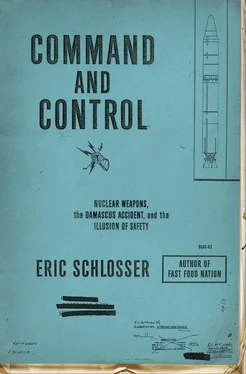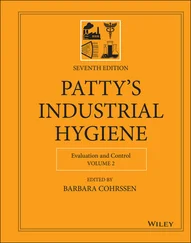PTS Team A was scheduled to pressurize the stage 2 oxidizer tank at the complex. The eight-man team was led by Senior Airman Charles T. Heineman, who would direct its work from the control center. Airmen David W. Aderhold, Eric Ayala, and Richard D. Willinghurst would remain topside to operate the nitrogen tank. Aderhold and Ayala would be in RFHCO suits. Airmen Roger A. Hamm and Gregory W. Lester would stay in the blast lock as backup to the men working in the silo, ready to put on their RFHCOs in an emergency. And Airmen David Powell and Jeffrey Plumb would enter the silo in RFHCOs, remove the pressure cap, and attach the nitrogen line.
Powell and Plumb hoped to get started on the missile early in the afternoon. But the work platforms wouldn’t descend from the silo walls. They were stuck in the upright position. A repair crew was working on them. Something was wrong with the hydraulics system, and troubleshooting with help from the tech manuals couldn’t fix it. The hassles continued to mount. The hydropneumatic accumulator was broken, and without it the platforms couldn’t be lowered — and the repair crew didn’t have the right parts. If pressure in the stage 2 oxidizer tank dropped any further, the missile would have to be taken off alert. SAC headquarters was never pleased when a missile went off alert. And so a helicopter was sent from Little Rock Air Force Base with the parts.
Meanwhile, Rodney Holder and Ron Fuller continued to go through the daily shift verification checklist, walking down the long corridor to the silo. The cableway was essentially a big steel pipe, braced with girders and springs, that stretched almost fifty yards from the blast lock to the silo. The floor was painted gray, the walls and ceilings turquoise. Bundles of pipes and cables snaked overhead and along both sides. It looked like the interior of a submarine that was somehow underground, not underwater. The silo’s nine levels were crammed with equipment, and the checklist there took about two hours to complete. It had hundreds of steps. Sometimes crews would cut corners to speed things up. They’d divide the labor — you check this air compressor, I’ll check that one — and violate the SAC two-man rule, roaming separately through the silo and comparing notes later. It was faster that way, the violation seemed trivial, and officers in the control center had no way of knowing what the enlisted men were doing in the silo. The television camera in the access portal, aimed at the entrapment area, was the only one in the complex. From the control center you couldn’t see what was happening in the cableways, the blast lock, the silo, or topside. There was no periscope. And one officer could not leave the other alone in the control center to check on what crew members were doing elsewhere. That would be a serious violation of the two-man rule.
Holder and Fuller did everything by the book that day. As members of an instructor crew, they took pride in being considered among the best at the job. A standardization-evaluation team was soon going to be judging their work, and Holder wanted a high score. Doing things properly added only fifteen minutes or so to the job. Before joining the Air Force he’d been a construction worker, building highway bridges in rural Arkansas. A career in the military hadn’t appealed to him, at first. His father was a former NFL player who joined the Naval Reserve during the Korean War and wound up spending more than two decades as a naval officer. Holder had attended grade schools in three different countries and high schools in four different states. At the age of nineteen, he liked doing construction work but worried about the future. The military promised a more interesting and rewarding life. Joining the Navy wasn’t an option; Holder got seasick too easily. So he joined the Air Force, eager to learn about missiles. Working on the Titan II had revealed that, deep down, he was a techno geek. Holder knew his way around the complex better than any of the other crew members. He not only knew what everything was, he could explain how it worked. On September 18, 1980, he was twenty-four years old and had been married for ten months.
The silo door motors on level 1A had to be checked, as did the sump at the bottom of level 9B, and everything in between. The equipment areas of the silo tended to be loud, but the launch duct was lined with sound dampeners, so that the roar of the engines wouldn’t cause vibrations and damage the missile. It was so quiet in the launch duct that on hot summer days, when the air-conditioners were struggling, warm oxidizer could be heard bubbling in the tanks. The only problem that Holder and Fuller noted that day was a faulty switch on the hard water tank. The complex had two large water tanks: one inside the silo, extending from levels 3 to 6, and one topside beyond the perimeter fence. The tank within the silo was considered “hard” because it was underground, and therefore shielded from a nuclear blast. It held one hundred thousand gallons of water that would spray into the silo moments before launch. The water helped to suppress the sound of the engines and ensured that flames wouldn’t rise up the silo and destroy the missile. The two water tanks were also essential for extinguishing a major fire at the complex. Like a broken float in a toilet that allows only one flush, a faulty switch on the hard water tank could prevent it from refilling automatically. Holder and Fuller noted the problem on the checklist and moved to the next step.
PTS Team A reached the complex around 3:30 in the afternoon, but the platforms still wouldn’t lower. Having nothing better to do, the team hung out and played cards around the table in level 1 of the control center. Jeffrey Plumb, who was new to the group, lay on one of the beds. They’d been working since early in the morning and were ready to be finished with the day. PTS teams and launch crews didn’t tend to socialize. The PTS guys were a different breed. Outside of work they had a reputation for being rowdy and wild. They had one of the most dangerous jobs in the Air Force — and at the end of the day they liked to blow off steam, drinking and partying harder than just about anyone else at the base. They were more likely to ride motorcycles, ignore speed limits, violate curfews, and toss a commanding officer into a shower, fully clothed, after consuming too much alcohol. They called the missiles “birds,” and they were attached to them and proud of them in the same way that good automobile mechanics care about cars. The danger of the oxidizer and the fuel wasn’t theoretical. It was part of the job. The daily risks often inspired a defiant, cavalier attitude among the PTS guys. Some of them had been known to fill a Ping-Pong ball with oxidizer and toss it into a bucket of fuel. The destruction of the steel bucket, accompanied by flames, was a good reminder of what they were working with. And if you were afraid of the propellants, as most people would be, you needed to find a different line of work.
Although low pressure in an oxidizer tank could mean a leak, PTS Team A wasn’t worried about it. This was the third day in a row that they’d been called out to 4–7. The missile in the silo had recently been recycled. The warhead and the propellants were removed during a recycle, and then the missile was lifted from the silo, hauled back to the base, carefully checked for corrosion and leaks. Later, the same missile might be returned to the complex, or a different one might be shipped there from storage. The fuel and oxidizer pressure often didn’t stabilize at the proper levels for weeks after a recycle. PTS teams were accustomed to adding more nitrogen two, three, four times until the tank pressures settled.
At the conclusion of the recycle at 4–7, a Titan II was placed in the silo, filled with propellants, and armed with a warhead. The missile’s serial number was 62-0006. The same missile that had been in the silo during the fire at the complex near Searcy now stood on the thrust mount at Launch Complex 374-7 north of Damascus. The odds were slim that the same Titan II airframe, out of dozens, would wind up in those two places. Bad luck, fate, sheer coincidence — whatever the explanation, neither the launch crew, nor the PTS team, knew that this missile had once been in a silo full of thick smoke and dying men.
Читать дальше












